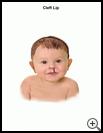
Cleft Lip and Cleft Palate
________________________________________________________________________
KEY POINTS
- Cleft lip and cleft palate are birth defects that happen when a baby’s lip or mouth does not form properly. Cleft means an opening.
- The cleft can be closed with surgery. Surgery can improve the look of a child’s face. It also may improve breathing, hearing, speech, and language.
- Make sure you know when your child should come back for a checkup. Keep all appointments for provider visits or tests. Your child's provider can help you find specialists and other resources. There are many treatment centers for cleft lip and cleft palate in the US and Canada.
________________________________________________________________________
What is a cleft lip or palate?
Cleft lip and cleft palate are birth defects that happen when a baby’s lip or mouth does not form properly. Cleft means an opening.
- Cleft lip is an opening in the upper lip. There may be a split on one or both sides of the upper lip. Rarely, the split is in the middle of the lip. The opening in the lip may be a small slit or it may be a large opening that goes through the lip and up into the nose.
- Cleft palate is an opening in the roof of the mouth, which is called the palate. The opening may be in just the soft part at the back of the mouth, or it may be in the bony (hard) part of the palate.
The middle ear is normally filled with air. A cleft palate may cause problems with the tubes that connect the ear to the back of the throat (called the eustachian tubes) and cause the middle ear to fill with fluid instead of air. This can cause hearing loss and more ear infections for a child with a cleft palate. The cleft palate may also cause problems with the teeth. Children with a cleft lip or cleft palate may have other birth defects that affect their ears, nose, or mouth.
Although some children with cleft lip and palate may have other medical problems, most have normal intelligence and develop normally in other ways.
What is the cause?
A baby's face and palate form during early pregnancy. A cleft happens if the face or lips do not come together completely. The exact cause is not known.
What are the symptoms?
The baby is born with one or more splits in the upper lip or a split in the roof of the mouth. Most children with this condition have an opening in both the lip and palate.
How is it diagnosed?
The cleft can be diagnosed by an exam of your baby after birth. Sometimes it may be seen with an ultrasound scan during pregnancy. An ultrasound scan uses sound waves to show pictures of the baby.
How is it treated?
The cleft can be closed with surgery. Surgery can improve the look of a child’s face. It also may improve breathing, hearing, speech, and language.
Cleft lip surgery is usually done before age 12 months, and cleft palate surgery is usually done before 18 months. Your child may need more surgeries as your child gets older.
Children with a cleft lip or cleft palate often have problems with breathing, feeding, and talking. Before your child has surgery to close the cleft, several kinds of specialists can help your child:
- It may be hard for your baby to suck when feeding. An occupational therapist can teach you how to feed your baby.
- Your baby's teeth will be affected if the cleft is in the gum or the hard palate. A dentist can check your baby's tooth development as your child grows.
- Your child may have a lot of ear infections or hearing problems. An ear, nose, and throat specialist may need to check your child's hearing regularly.
- The cleft may affect your child’s ability to talk. A speech and language therapist can help your child.
After the surgery, your child may still need to have therapy for a short time.
How can I help take care of my child?
Follow the full course of treatment prescribed by your healthcare provider. Ask your provider:
- How and when you will get your child’s test results
- How long it will take for your child to recover
- What prescription and nonprescription medicines are recommended or safe for you to give your child
- If there are activities your child should avoid and when your child can return to normal activities
- How to take care of your child at home
- What symptoms or problems you should watch for and what to do if your child has them
Make sure you know when your child should come back for a checkup. Keep all appointments for provider visits or tests.
Your child's provider can help you find specialists and other resources.
For more information, contact:
- Cleft Palate Foundation
800-242-5338
https://cleftline.org/ - Children's Craniofacial Association
800-535.3643
https://ccakids.org/ - American Speech-Language-Hearing Association
800-638-8255
https://www.asha.org/
Last modified: 2020-11-02
Last reviewed: 2020-11-02

